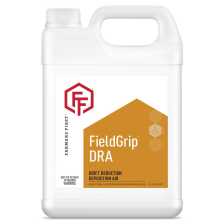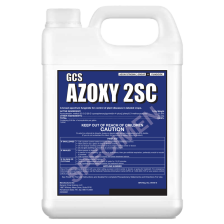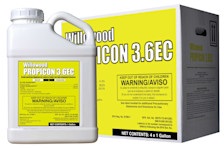Fungicides 101: Everything Farmers Need to Know About Fungicides
This guide includes the following sections:
What Are Fungicides?
Fungicides are pesticides that prevent, kill, mitigate or inhibit parasitic fungi and their reproductive spores. They are commonly used in agriculture to prevent or treat fungal diseases detrimental to crop production.
Fungicides, which can be used on nearly every crop type and in conventional and organic production, generally work by immobilizing critical metabolic pathways to prevent spore germination or hyphal growth. In agricultural production, fungicides may be applied via a seed treatment, in-furrow at planting or as an in-season foliar application.
How Are Fungicides Classified?
Fungicides can be classified in several ways, including based on:
Plant mobility
Mode of action
Curative or preventive protection benefits
Plant Mobility
Fungicides may have either contact or systemic activity in the plant.
Contact fungicides aren’t absorbed by plant tissue; instead, they offer a protective barrier that protects against pathogen entry. Contact fungicides are preventive because they must be applied before a disease penetrates plant tissue. They do not protect new plant growth or move to the underside of leaves where they may be needed most; if disease pressure is high, consider adding a systemic or translaminar fungicide to the tank mix.
Systemic fungicides have movement capabilities within the plant tissue. The systemic movement varies depending on the fungicide’s active ingredients and formulation. Some products are locally systemic, with limited translocation beyond the application site. Xylem-mobile fungicides move upward from the point of entry via xylem cells. Some fungicides translocate throughout the plant via the xylem and phloem cells. Translaminar fungicides aren’t truly systemic, but they provide movement from the top to the underside of leaves and vice versa.
Mode of Action
Mode of action refers to how the fungicide controls the fungal pathogen. The most common fungicide modes of action for agricultural applications include respiration inhibitors (Groups 7, 11 and 29) and sterol biosynthesis inhibitors (Group 3).
Fungicides from these four groups are widely used to manage a broad spectrum of crop fungal diseases, which can lead to fungicide resistance. Rotating fungicide modes of action and using products with multiple modes of action can help reduce the risk of resistant fungal populations.
Preventive or Curative Protection
Preventive fungicides must be applied before pathogen exposure to limit disease entry into plant tissue.
Curative fungicides may be applied after an initial disease infection and generally stop or slow disease progression if applied within 24 to 72 hours of pathogen exposure, depending on the fungicide.
Despite their name, curative fungicides don’t “cure” a plant of disease and aren’t effective on advanced disease infections. However, curative fungicides are an excellent option to stop early pathogen growth in plant cells if applied in the first few days following infection.
Generally, it’s best to take a proactive approach and apply all fungicides before disease infection occurs.
Why Do Farmers Use Fungicide?
Farmers apply fungicides to protect crops from diseases that reduce plant health, yield and quality potential. Proactively applying fungicides can keep plants strong and healthy through harvest, making the harvest process more efficient by reducing lodged crops.
Benefits of a fungicide application include:
Increased photosynthesis: With more healthy leaf area, plants can more effectively use nutrients to achieve maximum yield.
Greater stress tolerance: Vigorous plants are better at withstanding stressors like drought or extreme temperature variation.
Increased water use efficiency: Healthy stalks and leaves are more efficient at using water, leading to an extended grain fill period, thus more opportunity to develop yield.
Increased standability: With fewer stalk diseases, you’ll have fewer stalk issues and less lodging, leading to increased yield (because you're reducing ear loss at harvest).
Are Fungicide Applications Profitable?
Fungicide profitability will vary year-to-year depending on the disease pressure, cost of inputs and crop value. Generally, even in years when disease pressure is low, fungicides can provide plant health benefits that keep leaves greener longer to maximize grain and fruit production.
Fungicides can provide a positive return on investment when:
You choose the right product. By selecting a fungicide that provides control of the most common diseases in your geography, you can increase the likelihood of effectiveness. That increases the ROI potential of your fungicide application.
You make a timely application. When a fungal disease is present at application, a fungicide can halt the growth of the current pathogens and protect against another disease incidence. If no disease is evident at the time of application, a fungicide can also help to protect from any potential fungal infections.
When to Apply Fungicide
Application timing is critical because, even with curative fungicides, applications must be made within a few days of infection to be effective. It’s generally best to apply a fungicide before a disease infection occurs to maximize fungicide ROI. Diligent scouting is important to identify disease pressure in fields while they are still treatable.
Foliar applications made between corn's VT and R1 growth stages provide the greatest yield benefit.
For soybeans, target an application around the beginning pod stage (R3) to maximize return on investment. A two-pass fungicide program may offer more plant protection in heavy disease-pressure years or if disease sets in early. Consult with your agronomist for specific application timing recommendations based on field conditions.
If possible, apply systemic fungicides during humid and cloudy conditions so plant cuticles are open for faster plant absorption. Applying fungicides in the morning is preferable to reduce the risk of volatilization and drift.
If applying a fungicide on every acre isn’t feasible due to budget or logistical limitations, consider these factors and prioritize foliar fungicide applications accordingly:
Hybrid/varietal disease susceptibility
Tillage practices (no-till fields may harbor more disease pathogens)
History of disease and crop rotation (non-rotated fields may be at greater risk for diseases)
Planting date
Hybrid/variety maturity
Weather forecasts
Grain price
Yield potential
How to Apply Fungicide
Fungicides can be applied in several ways, including:
As a seed treatment
In-furrow at planting
Foliar spray
Fungicide seed treatments effectively control soil-borne fungal pathogens, including Pythium, Phytophthora, Rhizoctonia and Fusarium, that may cause seed rot and seedling diseases. Products that contain mefenoxam and metalaxyl effectively control Rhizoctonia and Phytophthora and can be combined with other active ingredients to manage a broad spectrum of soil-borne diseases. Most corn hybrids include a standard seed treatment, but soybeans may not be pre-treated. Consult your agronomist for more information about seed treatment options that are a good fit for your acres.
In-furrow fungicides are applied at planting to offer extra protection against early-season fungal diseases. They can help support vigorous emergence, which offers season-long crop benefits. Some in-furrow fungicide formulations may be applied with starter fertilizers to add application convenience and efficiency.
Foliar fungicides are applied via ground or aerial spray to protect against a broad spectrum of crop diseases. These application guidelines can help you maximize the ROI of your foliar fungicide applications.
When applying fungicide, be sure to:
Calibrate spray equipment to ensure even spray distribution across the field.
Use adequate spray volumes (15 to 20 gallons per acre) to ensure active ingredients cover plants deep into the canopy.
Choose fungicides that are effective against the diseases you want to manage.
Make timely fungicide applications before diseases develop.
Refer to product labels before mixing fungicides or adding adjuvants to avoid product antagonism and phytotoxicity risks.
Add appropriate, labeled adjuvants to the tank mix to reduce the risk of off-target movement and increase plant absorption. Consider including IN-Zorb™ ADV, a nonionic surfactant that reduces the surface tension of droplets to enable more uniform leaf spreading. FieldGrip™ DRA is a high-concentrate emulsifiable deposition aid and drift management adjuvant that can be used with most fungicides. Neither product contains APE or NPE, which have been associated with Arrested Ear Syndrome in corn.
How to Address Crop Diseases Using Fungicide
Using Fungicide to Treat Gray Leaf Spot in Corn
Gray leaf spot is one of the most damaging foliar corn diseases because its lesions reduce the plant's green leaf area and photosynthetic activity. This results in lower yield and grain quality, with smaller kernel sizes and lower test weights. Reduced photosynthesis can also increase the risk for late-season stalk lodging and infection by stalk rot diseases.
Moderate to warm temperatures and high humidity or wet conditions favor gray leaf spot development. Begin scouting between the V10 and V14 growth stages to assess crop risk. If disease is present and/or conditions favor disease development, a foliar fungicide can help protect the crop.
Strobilurin fungicides, including Azoxystrobin 2.08, and strobilurin/triazole premixes, including Azox 1.18 + Prop 1.02 Value Pick, are excellent options for controlling gray leaf spot. Apply the foliar fungicide at tasseling through early silking (VT to R1) for the most effective treatment. Follow the label instructions for proper application timing, rate, carrier volume, safety and preharvest interval precautions.
Using Fungicide to Treat Soybean Cyst Nematode
Soybean cyst nematodes (SCN) are plant-parasitic roundworms that penetrate plant roots and feed within the plant’s vascular system. It is the most yield-limiting soybean disease in the U.S. and increases the crop’s risk for other soil-borne diseases such as brown stem rot, sudden death syndrome, and Fusarium root rot. Adult nematode root feeding can significantly reduce yield as infected plants become yellow, stunted and necrotic.
Several factors can favor SCN development in fields. High soil pH, sandy, well-drained soils and fields with continuous soybean rotations tend to be at a higher risk for SCN. Soil samples should be taken if SCN is suspected in fields. Test results can confirm the presence of SCN and provide population estimates for choosing suitable treatments.
SCN can be managed with an integrated strategy that includes choosing SCN-resistant soybean varieties, rotating soybeans with other non-host crops and controlling weeds, moisture and fertility to reduce plant stress. For fields with heavy SCN pressure or a history of disease, adding a seed treatment, such as ILeVO®, with specific active ingredients for SCN control, is recommended.
Using Fungicide to Treat Common Rust in Corn
Common rust is a fungal disease in corn caused by windblown spores originating from southern corn-growing regions. It is generally not a disease of economic significance in field corn (unlike southern rust) but can be problematic in seed corn and sweet corn production. Disease impacts include reduced photosynthesis due to disease lesions, which results in lower yield and grain quality. Reduced sugar production from photosynthesis also reduces stalk strength and increases the risk of stalk diseases. The latest planted corn in an area generally has the highest risk for yield loss.
Common rust develops in moist and cool conditions and typically progresses as corn matures in late summer if the environment remains conducive. Large circular or elongated pustules form on the top and undersides of leaves. The disease can spread quickly across the field, so scouting consistently throughout the season is important.
If a foliar fungicide application is warranted (especially for high-value specialty crops), it should be applied as soon as the first few disease pustules are observed. Strobilurin fungicides, including GCS Azoxy 2SC, and triazoles, including Willowood Propicon 3.6EC, are excellent options for controlling common rust in corn. A premix that includes both fungicide groups can offer broad-spectrum disease control for managing other diseases simultaneously.
Fungicides from FBN®
FBN has the diverse array of fungicides you need to proactively manage diseases and keep your operation running smoothly.
With 24/7 digital shopping access, direct-to-farm delivery, transparent pricing and savings opportunities, and detailed label information for each product, FBN offers the information and products you need to build an effective crop protection strategy this season.
Popular Fungicides Available from FBN:
Related Resources
Acetochlor 101: Everything Farmers Need to Know About Acetochlor
Atrazine 101: Everything Farmers Need to Know About Atrazine
Bifenthrin 101: Everything Farmers Need to Know About Bifenthrin
Biostimulants 101: Everything Growers Need to Know About Biostimulants
Clopyralid 101: Everything Farmers Need to Know About Clopyralid
Clethodim 101: Everything Farmers Need to Know About Clethodim
Crop Nutrition 101: Everything Farmers Need to Know About Crop Nutrition
Fungicides 101: Everything Farmers Need to Know About Fungicides
Glyphosate 101: Everything Farmers Need to Know About Glyphosate
Glufosinate 101: Everything Farmers Need to Know About Glufosinate
Herbicides 101: Everything Growers Need to Know About Herbicides
Inoculants 101: Everything Farmers Need to Know About Inoculants
Insecticides 101: Everything Farmers Need to Know About Insecticides
Lambda-Cyhalothrin 101: Everything Farmers Need to Know About Lambda-Cy
Metolachlor: Everything Farmers Need to Know About Metolachlor
Nitrogen 101: Everything Farmers Need to Know About Nitrogen
Paraquat 101: Everything Farmers Need to Know About Paraquat
© 2014 - 2025 Farmer's Business Network, Inc. All rights Reserved. The sprout logo, “Farmers Business Network”, “FBN”, "Farmers First", “FBN Direct” , "F2F", and "F2F Genetics Network" are trademarks or registered trademarks of Farmer's Business Network, Inc.
FBN Direct products and services and other products distributed by FBN Direct are offered by FBN Inputs, LLC and are available only in states where FBN Inputs, LLC is licensed and where those products are registered for sale or use, if applicable. If applicable, please check with your local extension service to ensure registration status. Nothing contained on this page, including the prices listed should be construed as an offer for sale, or a sale of products. All products and prices are subject to change at any time and without notice and excludes CA mills tax and MN ACRRA fees. Terms and conditions apply.
ALWAYS READ AND FOLLOW LABEL DIRECTIONS. It is a violation of federal and state law to use any pesticide product other than in accordance with its label. The distribution, sale and use of an unregistered pesticide is a violation of federal and/or state law and is strictly prohibited. We do not guarantee the accuracy of any information provided on this page or which is provided by us in any form. It is your responsibility to confirm prior to purchase and use that a product is labeled for your specific purposes, including, but not limited to, your target crop or pest and its compatibility with other products in a tank mix and that the usage of a product is otherwise consistent with federal, state and local laws. We reserve the right to restrict sales on a geographic basis in our sole discretion. You must have a valid applicator license to use restricted use pesticides. Please consult your state department of agriculture for complete rules and regulations on the use of restricted use pesticides, as some products require specific record-keeping requirements.
All product recommendations and other information provided is for informational purposes only. It is not intended to be a substitute for consulting the product label or for specific agronomic, business,or professional advice. Where specific advice is necessary or appropriate, consult with a qualified advisor. Neither Farmer's Business Network Inc. nor any of its affiliates makes any representations or warranties, express or implied, as to the accuracy or completeness of the statements or any information contained in the material and any liability therefore is expressly disclaimed.


